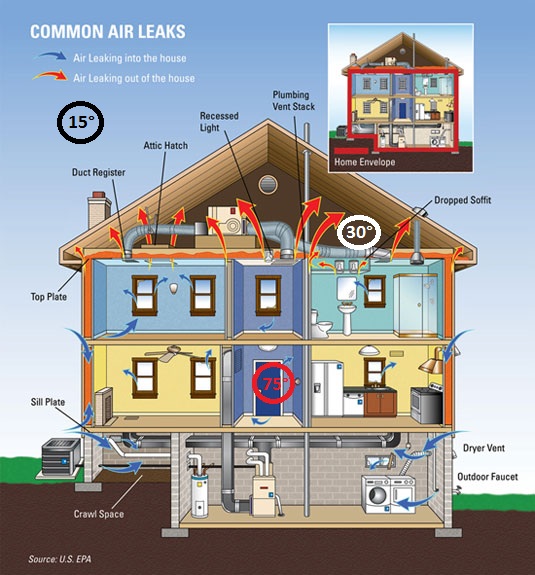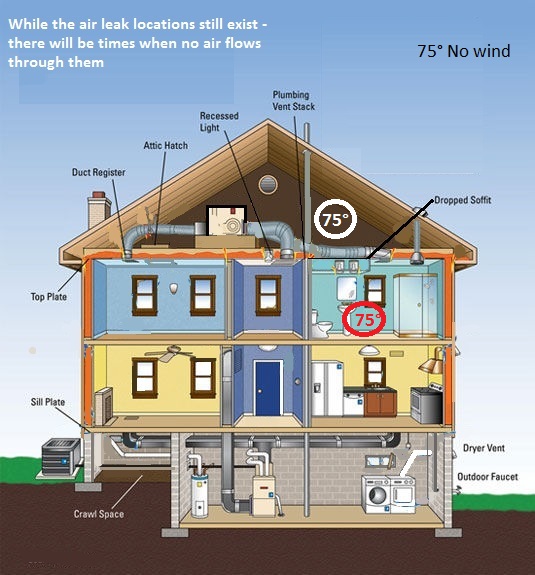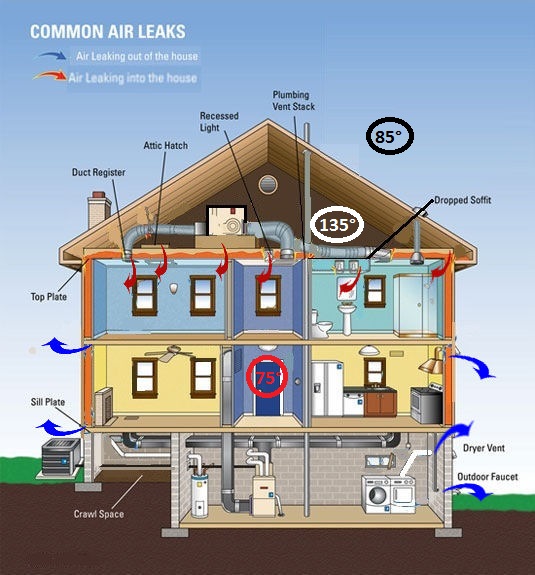 Stack or Chimney Effect describes the natural phenomena of how air moves into and out of a building, a chimney, a flue pipe, or other type of container. This is caused mainly by pressure & temperature differences – the bigger the difference, the bigger the effect is.
Stack or Chimney Effect describes the natural phenomena of how air moves into and out of a building, a chimney, a flue pipe, or other type of container. This is caused mainly by pressure & temperature differences – the bigger the difference, the bigger the effect is.
For most people the concept seems simple – warm air rises, cool air replaces it and that’s it. I would dare say that the diagram below is probably the most popular ones used to help explain Stack Effect & how air leakage impacts it.
While rare there are times when everything is perfectly in balance & there is no air flow.
This one is commonly referred to as summer or reversed stack effect. Instead of cold air being “pulled” in, it is essentially being pushed out due to the expansion of the air above it – much like a hot air balloon.
Stratification is an interesting item and most commonly seen in large rooms with radiant heating, commercial buildings, and in chimneys. For radiant heat the lower areas are actually heated & the higher you go the lower the temperature goes
 Ahhh the dreaded my house smokes up when I light the fireplace aka the cold air slug. The best way to take care of this to open a window some & hold a lit match or paper in the flue area to preheat or prime the flue before lighting the fire. PLEASE NOTE: you should have your chimney checked professionally each year especially if this is a reoccurring problem or it happens after the fire has been going. While some “energy auditors” can help diagnose some causes, your first call should be to a specialist Ahhh the dreaded my house smokes up when I light the fireplace aka the cold air slug. The best way to take care of this to open a window some & hold a lit match or paper in the flue area to preheat or prime the flue before lighting the fire. PLEASE NOTE: you should have your chimney checked professionally each year especially if this is a reoccurring problem or it happens after the fire has been going. While some “energy auditors” can help diagnose some causes, your first call should be to a specialist |
The wind also plays a major part & is well known for turning everything on its side or even appearing to reverse what one be expecting.
 Interestingly some like to tout the “revolving door” as being required or invented mainly to help solve the chimney effect issues in skyscrapers. While these can help with it, the “Tür ohne Luftzug” or “Door without draft of air” and the “Storm-Door Structure” were originally devised to help keep out sound, snow, wind & dust from the streets while allowing people to pass through the doorway going opposite directions without colliding. The main reasons skyscrapers took off was the advent of the steel support structure & elevators. Interestingly some like to tout the “revolving door” as being required or invented mainly to help solve the chimney effect issues in skyscrapers. While these can help with it, the “Tür ohne Luftzug” or “Door without draft of air” and the “Storm-Door Structure” were originally devised to help keep out sound, snow, wind & dust from the streets while allowing people to pass through the doorway going opposite directions without colliding. The main reasons skyscrapers took off was the advent of the steel support structure & elevators.
The “door without draft” was patented in Berlin (German patent DE18349[8]) by H. Bockhacker on December 22, 1881. The revolving 3-panel “Storm-Door Structure” was patented by Theophilus Van Kannel, of Philadelphia (US patent 387,571) on August 7, 1888. |


